LAWS20060: Taxation Law of Australia Individual Assignment 2019
VerifiedAdded on 2023/01/16
|16
|3653
|22
Homework Assignment
AI Summary
This document provides a comprehensive solution to a Taxation Law assignment, specifically for the LAWS20060 course. The assignment covers various aspects of Australian taxation law, including capital gains tax (CGT), tax deductions, and income tax calculations. The solution addresses multiple questions, offering detailed explanations, case analysis, and references to relevant legislation and rulings. It explores topics such as asset effective life, tax offsets, taxation of Australian residents, personal use assets, CGT events, and the calculation of taxable income. Furthermore, it delves into deductions for business expenses, child care, and stolen goods, while also examining CGT implications for leases, land transactions, and main residences. The document concludes with a discussion on the taxability of prize winnings and the application of relevant laws and provisions.
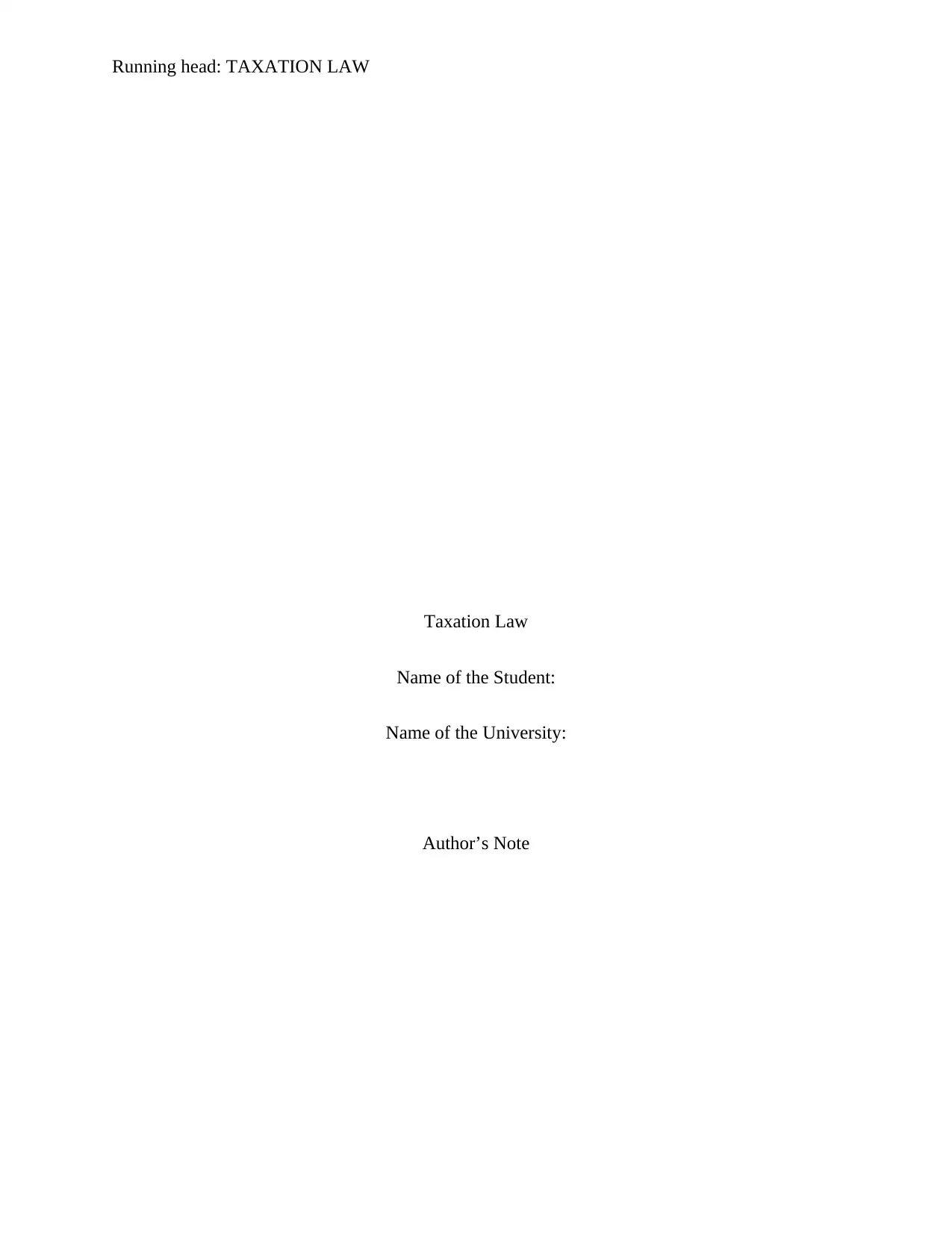
Running head: TAXATION LAW
Taxation Law
Name of the Student:
Name of the University:
Author’s Note
Taxation Law
Name of the Student:
Name of the University:
Author’s Note
Paraphrase This Document
Need a fresh take? Get an instant paraphrase of this document with our AI Paraphraser
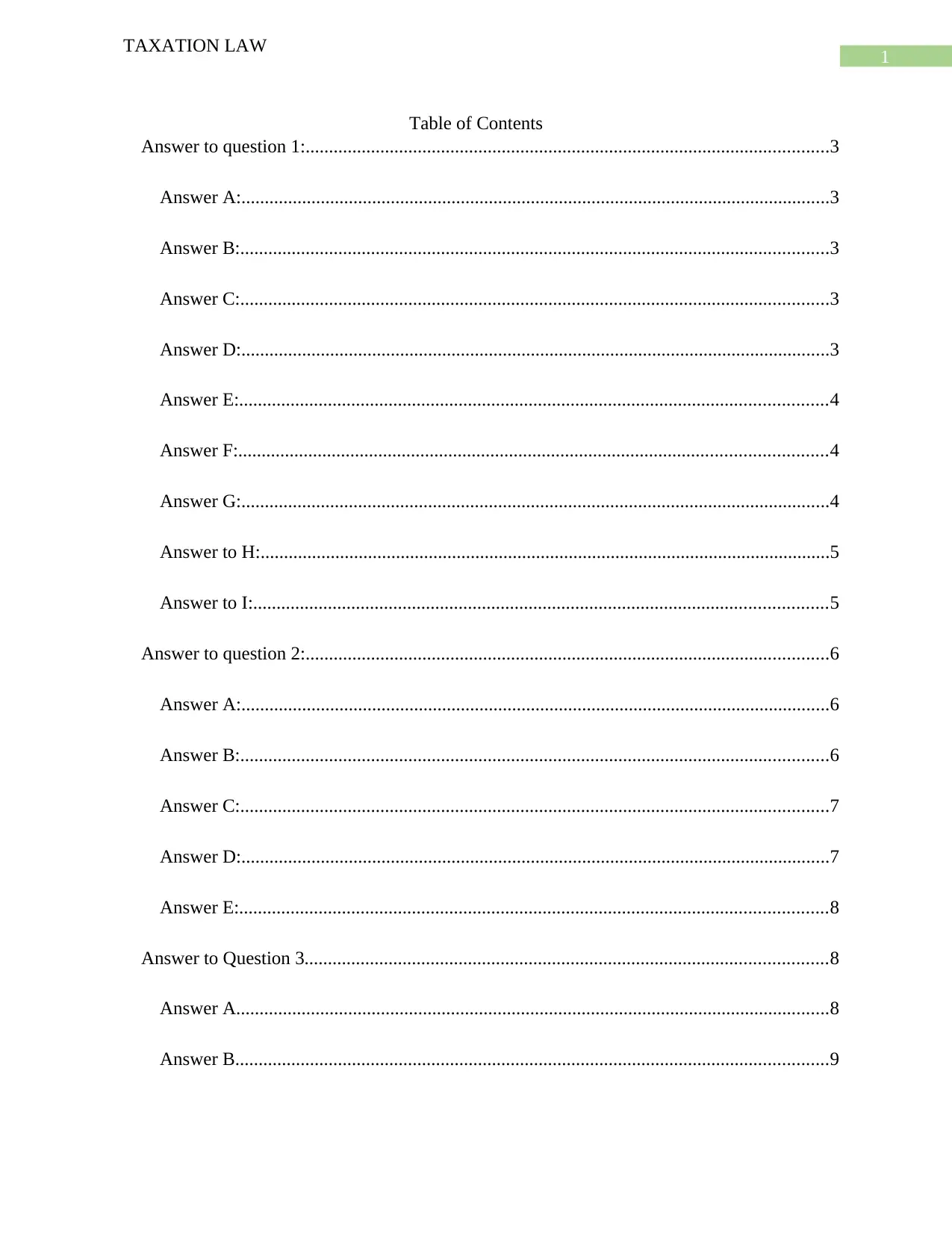
1
TAXATION LAW
Table of Contents
Answer to question 1:................................................................................................................3
Answer A:..............................................................................................................................3
Answer B:..............................................................................................................................3
Answer C:..............................................................................................................................3
Answer D:..............................................................................................................................3
Answer E:..............................................................................................................................4
Answer F:..............................................................................................................................4
Answer G:..............................................................................................................................4
Answer to H:..........................................................................................................................5
Answer to I:...........................................................................................................................5
Answer to question 2:................................................................................................................6
Answer A:..............................................................................................................................6
Answer B:..............................................................................................................................6
Answer C:..............................................................................................................................7
Answer D:..............................................................................................................................7
Answer E:..............................................................................................................................8
Answer to Question 3................................................................................................................8
Answer A...............................................................................................................................8
Answer B...............................................................................................................................9
TAXATION LAW
Table of Contents
Answer to question 1:................................................................................................................3
Answer A:..............................................................................................................................3
Answer B:..............................................................................................................................3
Answer C:..............................................................................................................................3
Answer D:..............................................................................................................................3
Answer E:..............................................................................................................................4
Answer F:..............................................................................................................................4
Answer G:..............................................................................................................................4
Answer to H:..........................................................................................................................5
Answer to I:...........................................................................................................................5
Answer to question 2:................................................................................................................6
Answer A:..............................................................................................................................6
Answer B:..............................................................................................................................6
Answer C:..............................................................................................................................7
Answer D:..............................................................................................................................7
Answer E:..............................................................................................................................8
Answer to Question 3................................................................................................................8
Answer A...............................................................................................................................8
Answer B...............................................................................................................................9
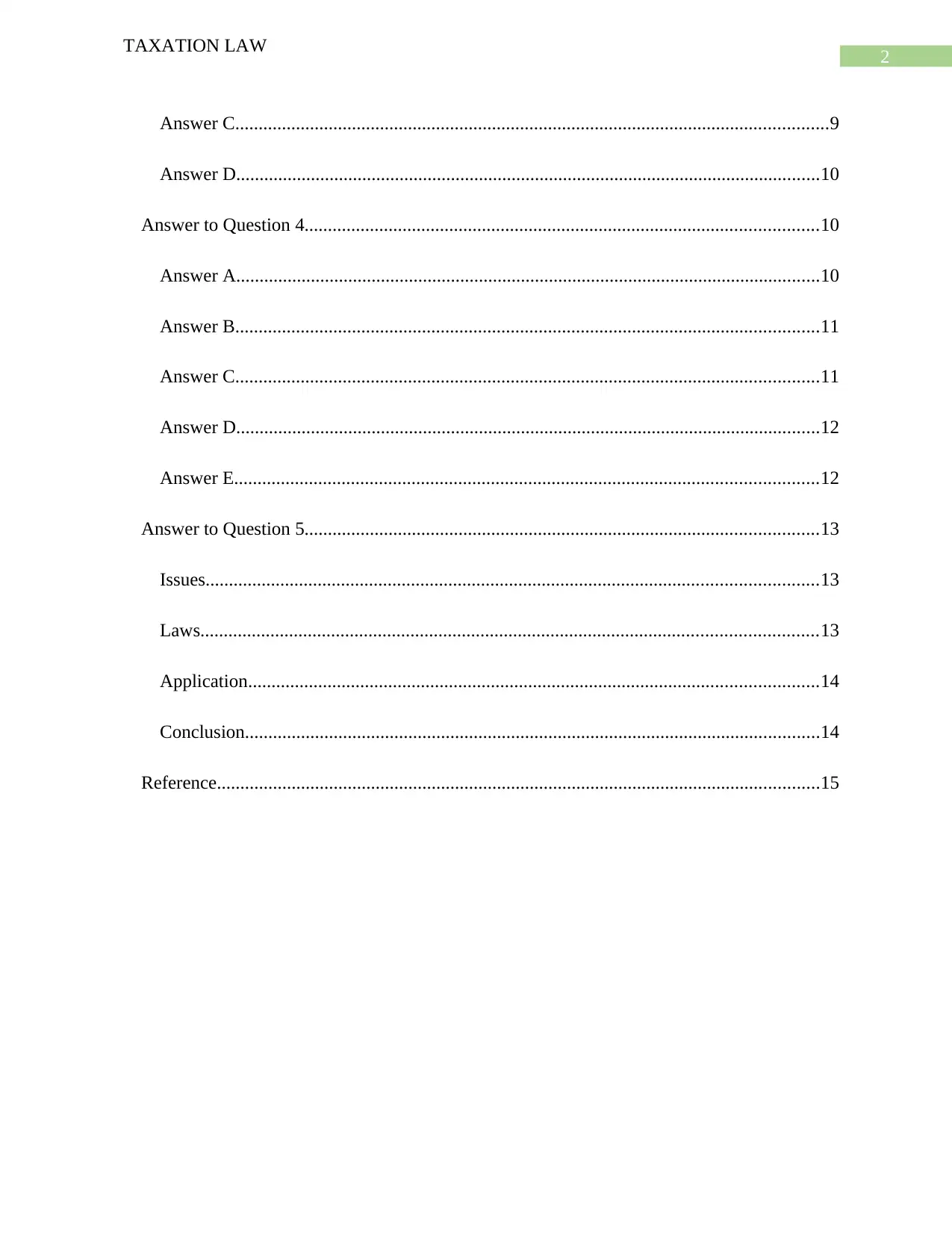
2
TAXATION LAW
Answer C...............................................................................................................................9
Answer D.............................................................................................................................10
Answer to Question 4..............................................................................................................10
Answer A.............................................................................................................................10
Answer B.............................................................................................................................11
Answer C.............................................................................................................................11
Answer D.............................................................................................................................12
Answer E.............................................................................................................................12
Answer to Question 5..............................................................................................................13
Issues...................................................................................................................................13
Laws....................................................................................................................................13
Application..........................................................................................................................14
Conclusion...........................................................................................................................14
Reference.................................................................................................................................15
TAXATION LAW
Answer C...............................................................................................................................9
Answer D.............................................................................................................................10
Answer to Question 4..............................................................................................................10
Answer A.............................................................................................................................10
Answer B.............................................................................................................................11
Answer C.............................................................................................................................11
Answer D.............................................................................................................................12
Answer E.............................................................................................................................12
Answer to Question 5..............................................................................................................13
Issues...................................................................................................................................13
Laws....................................................................................................................................13
Application..........................................................................................................................14
Conclusion...........................................................................................................................14
Reference.................................................................................................................................15
⊘ This is a preview!⊘
Do you want full access?
Subscribe today to unlock all pages.

Trusted by 1+ million students worldwide
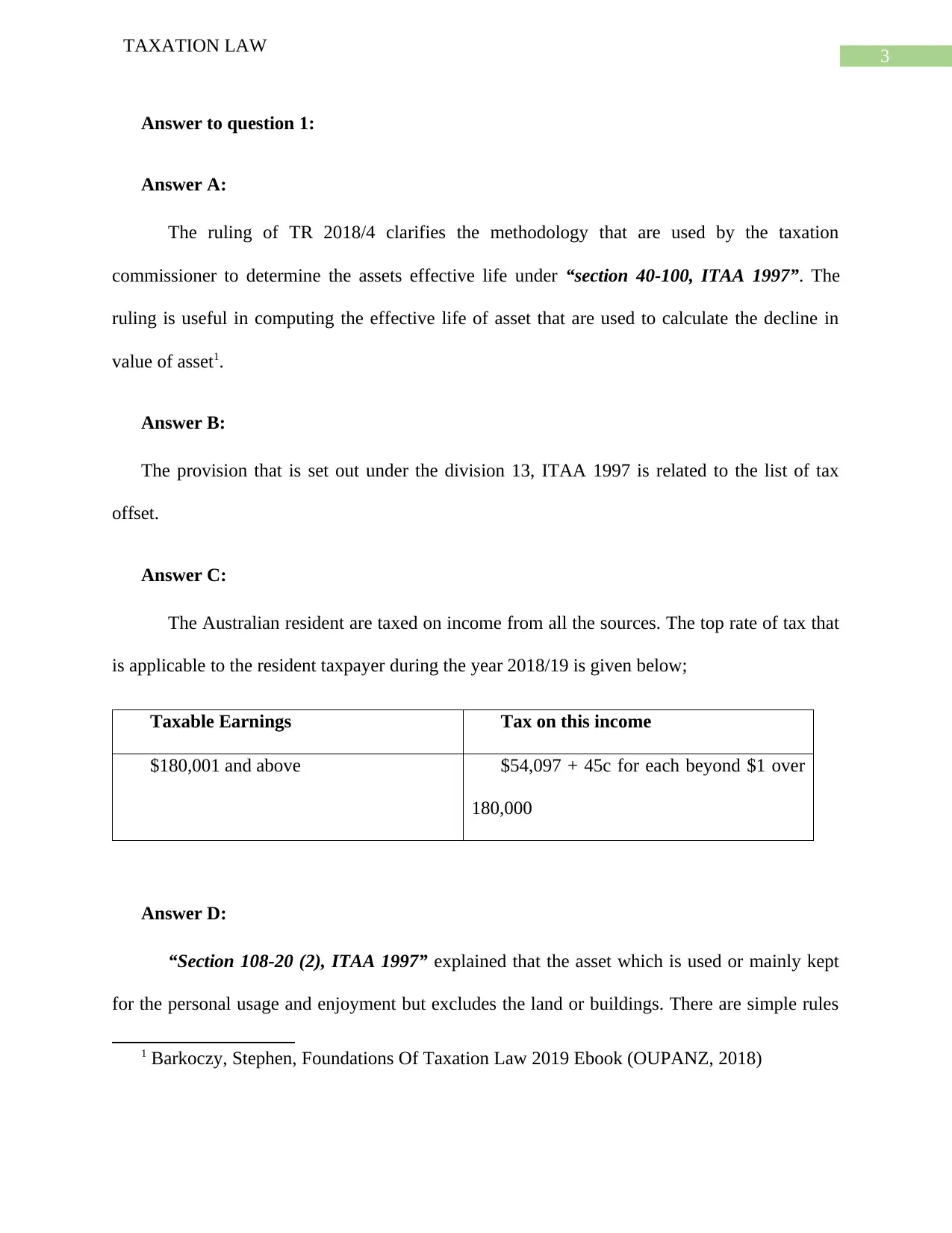
3
TAXATION LAW
Answer to question 1:
Answer A:
The ruling of TR 2018/4 clarifies the methodology that are used by the taxation
commissioner to determine the assets effective life under “section 40-100, ITAA 1997”. The
ruling is useful in computing the effective life of asset that are used to calculate the decline in
value of asset1.
Answer B:
The provision that is set out under the division 13, ITAA 1997 is related to the list of tax
offset.
Answer C:
The Australian resident are taxed on income from all the sources. The top rate of tax that
is applicable to the resident taxpayer during the year 2018/19 is given below;
Taxable Earnings Tax on this income
$180,001 and above $54,097 + 45c for each beyond $1 over
180,000
Answer D:
“Section 108-20 (2), ITAA 1997” explained that the asset which is used or mainly kept
for the personal usage and enjoyment but excludes the land or buildings. There are simple rules
1 Barkoczy, Stephen, Foundations Of Taxation Law 2019 Ebook (OUPANZ, 2018)
TAXATION LAW
Answer to question 1:
Answer A:
The ruling of TR 2018/4 clarifies the methodology that are used by the taxation
commissioner to determine the assets effective life under “section 40-100, ITAA 1997”. The
ruling is useful in computing the effective life of asset that are used to calculate the decline in
value of asset1.
Answer B:
The provision that is set out under the division 13, ITAA 1997 is related to the list of tax
offset.
Answer C:
The Australian resident are taxed on income from all the sources. The top rate of tax that
is applicable to the resident taxpayer during the year 2018/19 is given below;
Taxable Earnings Tax on this income
$180,001 and above $54,097 + 45c for each beyond $1 over
180,000
Answer D:
“Section 108-20 (2), ITAA 1997” explained that the asset which is used or mainly kept
for the personal usage and enjoyment but excludes the land or buildings. There are simple rules
1 Barkoczy, Stephen, Foundations Of Taxation Law 2019 Ebook (OUPANZ, 2018)
Paraphrase This Document
Need a fresh take? Get an instant paraphrase of this document with our AI Paraphraser
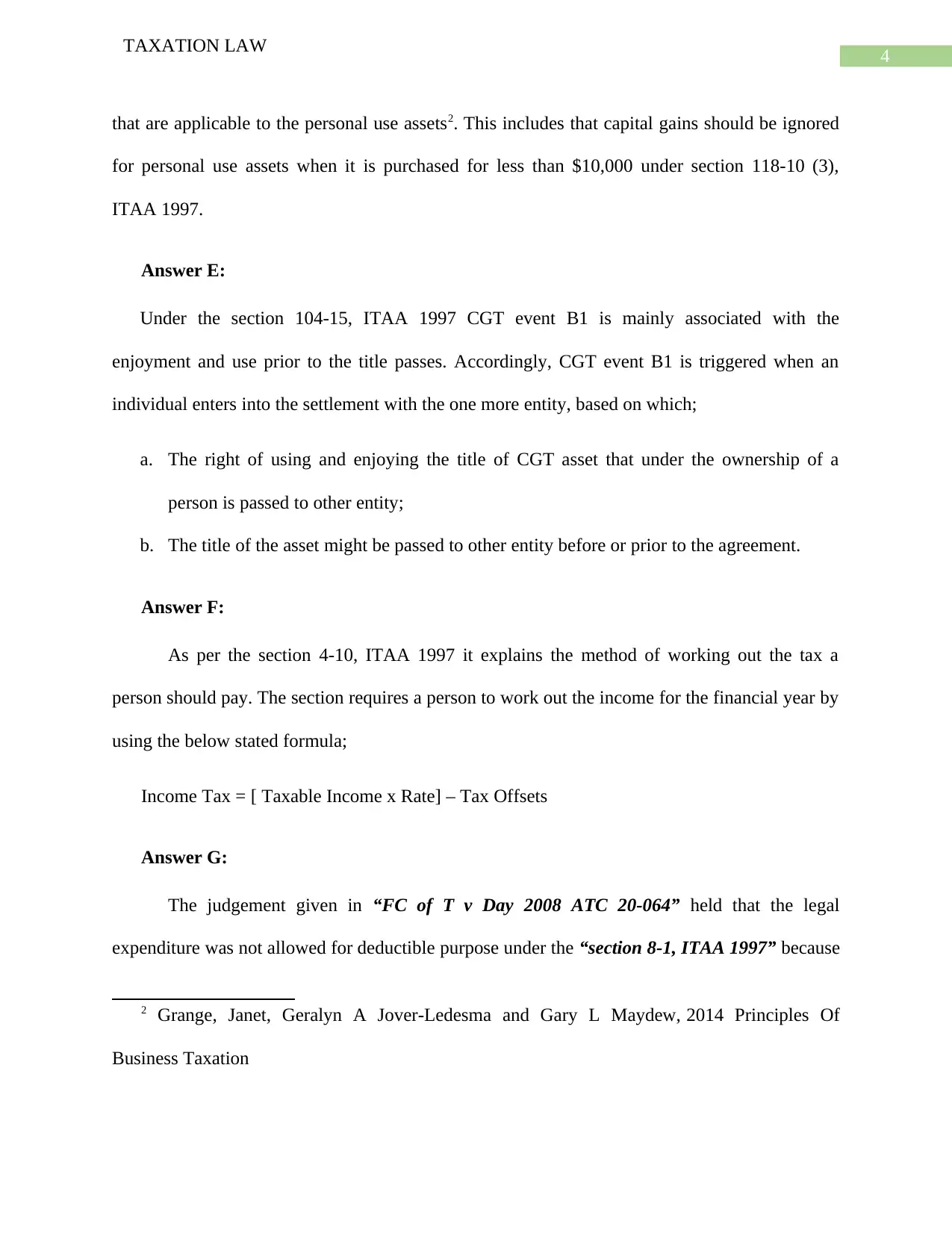
4
TAXATION LAW
that are applicable to the personal use assets2. This includes that capital gains should be ignored
for personal use assets when it is purchased for less than $10,000 under section 118-10 (3),
ITAA 1997.
Answer E:
Under the section 104-15, ITAA 1997 CGT event B1 is mainly associated with the
enjoyment and use prior to the title passes. Accordingly, CGT event B1 is triggered when an
individual enters into the settlement with the one more entity, based on which;
a. The right of using and enjoying the title of CGT asset that under the ownership of a
person is passed to other entity;
b. The title of the asset might be passed to other entity before or prior to the agreement.
Answer F:
As per the section 4-10, ITAA 1997 it explains the method of working out the tax a
person should pay. The section requires a person to work out the income for the financial year by
using the below stated formula;
Income Tax = [ Taxable Income x Rate] – Tax Offsets
Answer G:
The judgement given in “FC of T v Day 2008 ATC 20-064” held that the legal
expenditure was not allowed for deductible purpose under the “section 8-1, ITAA 1997” because
2 Grange, Janet, Geralyn A Jover-Ledesma and Gary L Maydew, 2014 Principles Of
Business Taxation
TAXATION LAW
that are applicable to the personal use assets2. This includes that capital gains should be ignored
for personal use assets when it is purchased for less than $10,000 under section 118-10 (3),
ITAA 1997.
Answer E:
Under the section 104-15, ITAA 1997 CGT event B1 is mainly associated with the
enjoyment and use prior to the title passes. Accordingly, CGT event B1 is triggered when an
individual enters into the settlement with the one more entity, based on which;
a. The right of using and enjoying the title of CGT asset that under the ownership of a
person is passed to other entity;
b. The title of the asset might be passed to other entity before or prior to the agreement.
Answer F:
As per the section 4-10, ITAA 1997 it explains the method of working out the tax a
person should pay. The section requires a person to work out the income for the financial year by
using the below stated formula;
Income Tax = [ Taxable Income x Rate] – Tax Offsets
Answer G:
The judgement given in “FC of T v Day 2008 ATC 20-064” held that the legal
expenditure was not allowed for deductible purpose under the “section 8-1, ITAA 1997” because
2 Grange, Janet, Geralyn A Jover-Ledesma and Gary L Maydew, 2014 Principles Of
Business Taxation
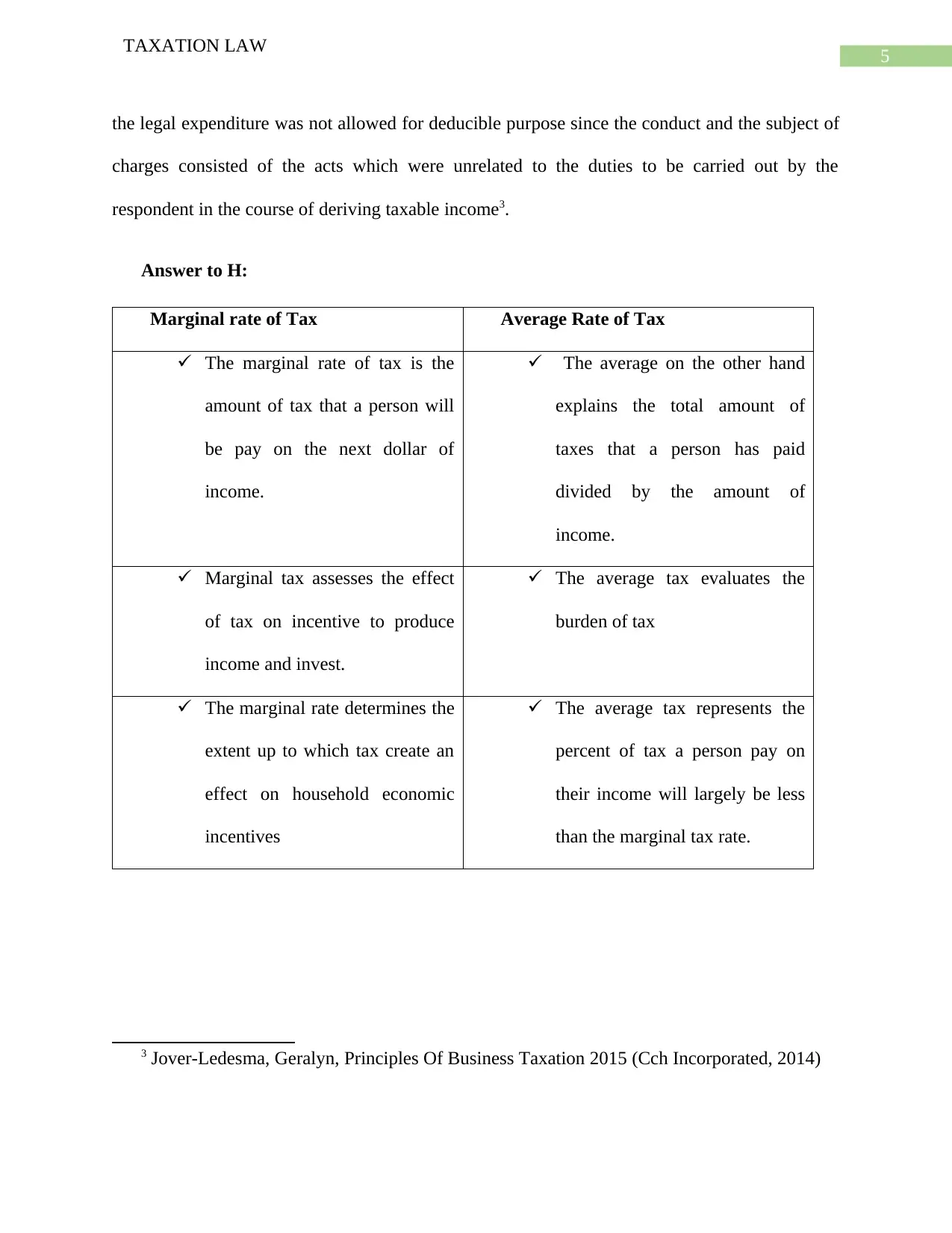
5
TAXATION LAW
the legal expenditure was not allowed for deducible purpose since the conduct and the subject of
charges consisted of the acts which were unrelated to the duties to be carried out by the
respondent in the course of deriving taxable income3.
Answer to H:
Marginal rate of Tax Average Rate of Tax
The marginal rate of tax is the
amount of tax that a person will
be pay on the next dollar of
income.
The average on the other hand
explains the total amount of
taxes that a person has paid
divided by the amount of
income.
Marginal tax assesses the effect
of tax on incentive to produce
income and invest.
The average tax evaluates the
burden of tax
The marginal rate determines the
extent up to which tax create an
effect on household economic
incentives
The average tax represents the
percent of tax a person pay on
their income will largely be less
than the marginal tax rate.
3 Jover-Ledesma, Geralyn, Principles Of Business Taxation 2015 (Cch Incorporated, 2014)
TAXATION LAW
the legal expenditure was not allowed for deducible purpose since the conduct and the subject of
charges consisted of the acts which were unrelated to the duties to be carried out by the
respondent in the course of deriving taxable income3.
Answer to H:
Marginal rate of Tax Average Rate of Tax
The marginal rate of tax is the
amount of tax that a person will
be pay on the next dollar of
income.
The average on the other hand
explains the total amount of
taxes that a person has paid
divided by the amount of
income.
Marginal tax assesses the effect
of tax on incentive to produce
income and invest.
The average tax evaluates the
burden of tax
The marginal rate determines the
extent up to which tax create an
effect on household economic
incentives
The average tax represents the
percent of tax a person pay on
their income will largely be less
than the marginal tax rate.
3 Jover-Ledesma, Geralyn, Principles Of Business Taxation 2015 (Cch Incorporated, 2014)
⊘ This is a preview!⊘
Do you want full access?
Subscribe today to unlock all pages.

Trusted by 1+ million students worldwide
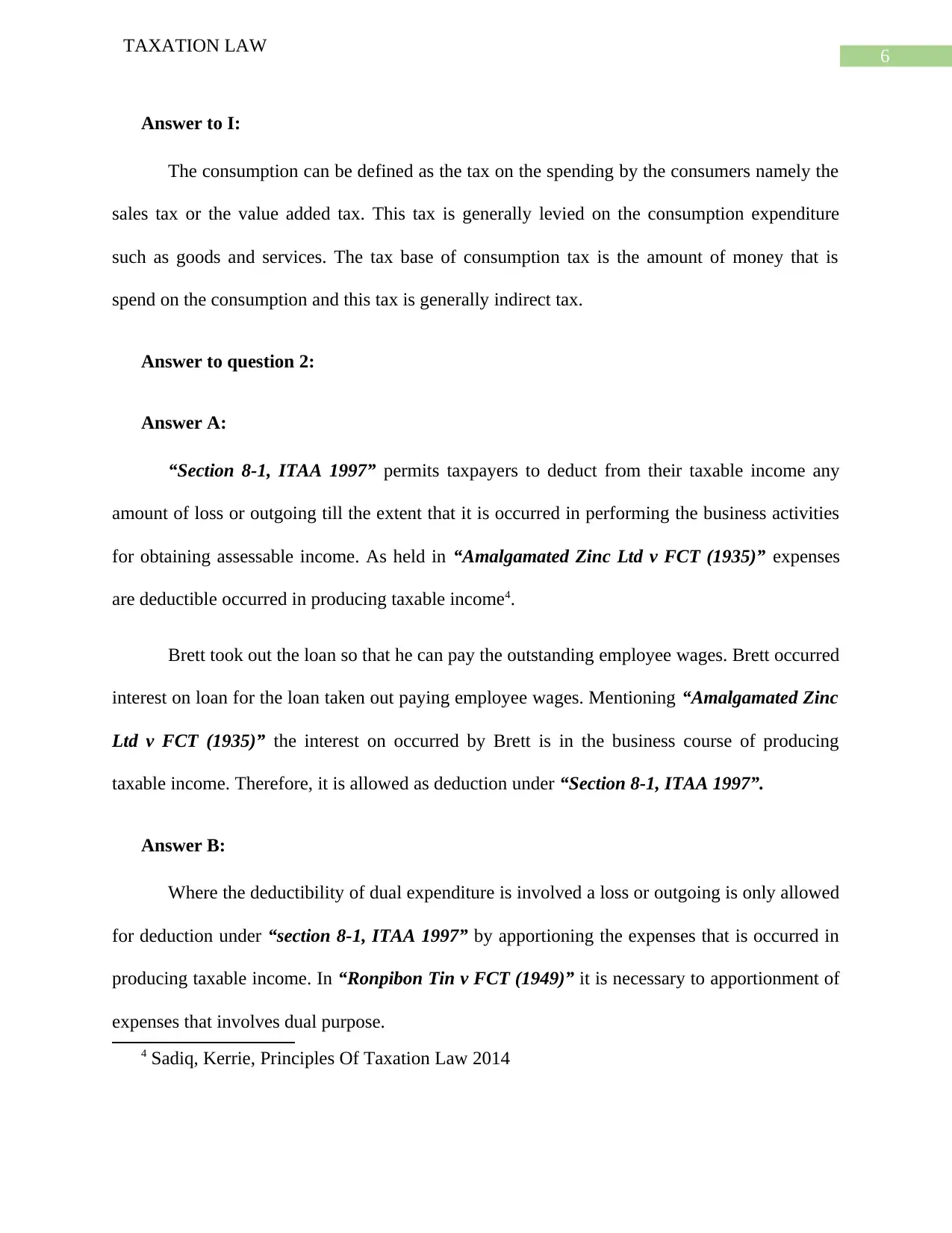
6
TAXATION LAW
Answer to I:
The consumption can be defined as the tax on the spending by the consumers namely the
sales tax or the value added tax. This tax is generally levied on the consumption expenditure
such as goods and services. The tax base of consumption tax is the amount of money that is
spend on the consumption and this tax is generally indirect tax.
Answer to question 2:
Answer A:
“Section 8-1, ITAA 1997” permits taxpayers to deduct from their taxable income any
amount of loss or outgoing till the extent that it is occurred in performing the business activities
for obtaining assessable income. As held in “Amalgamated Zinc Ltd v FCT (1935)” expenses
are deductible occurred in producing taxable income4.
Brett took out the loan so that he can pay the outstanding employee wages. Brett occurred
interest on loan for the loan taken out paying employee wages. Mentioning “Amalgamated Zinc
Ltd v FCT (1935)” the interest on occurred by Brett is in the business course of producing
taxable income. Therefore, it is allowed as deduction under “Section 8-1, ITAA 1997”.
Answer B:
Where the deductibility of dual expenditure is involved a loss or outgoing is only allowed
for deduction under “section 8-1, ITAA 1997” by apportioning the expenses that is occurred in
producing taxable income. In “Ronpibon Tin v FCT (1949)” it is necessary to apportionment of
expenses that involves dual purpose.
4 Sadiq, Kerrie, Principles Of Taxation Law 2014
TAXATION LAW
Answer to I:
The consumption can be defined as the tax on the spending by the consumers namely the
sales tax or the value added tax. This tax is generally levied on the consumption expenditure
such as goods and services. The tax base of consumption tax is the amount of money that is
spend on the consumption and this tax is generally indirect tax.
Answer to question 2:
Answer A:
“Section 8-1, ITAA 1997” permits taxpayers to deduct from their taxable income any
amount of loss or outgoing till the extent that it is occurred in performing the business activities
for obtaining assessable income. As held in “Amalgamated Zinc Ltd v FCT (1935)” expenses
are deductible occurred in producing taxable income4.
Brett took out the loan so that he can pay the outstanding employee wages. Brett occurred
interest on loan for the loan taken out paying employee wages. Mentioning “Amalgamated Zinc
Ltd v FCT (1935)” the interest on occurred by Brett is in the business course of producing
taxable income. Therefore, it is allowed as deduction under “Section 8-1, ITAA 1997”.
Answer B:
Where the deductibility of dual expenditure is involved a loss or outgoing is only allowed
for deduction under “section 8-1, ITAA 1997” by apportioning the expenses that is occurred in
producing taxable income. In “Ronpibon Tin v FCT (1949)” it is necessary to apportionment of
expenses that involves dual purpose.
4 Sadiq, Kerrie, Principles Of Taxation Law 2014
Paraphrase This Document
Need a fresh take? Get an instant paraphrase of this document with our AI Paraphraser
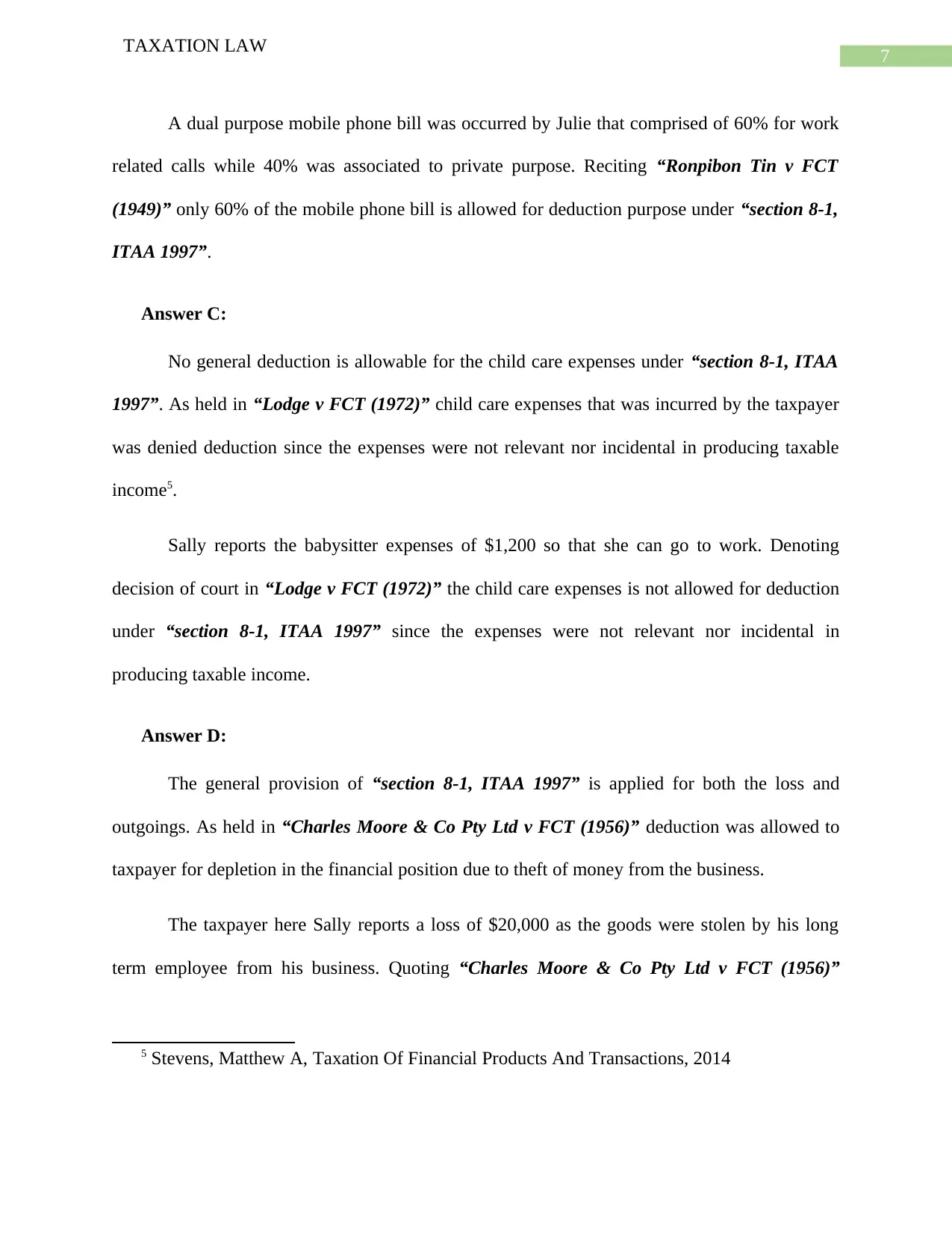
7
TAXATION LAW
A dual purpose mobile phone bill was occurred by Julie that comprised of 60% for work
related calls while 40% was associated to private purpose. Reciting “Ronpibon Tin v FCT
(1949)” only 60% of the mobile phone bill is allowed for deduction purpose under “section 8-1,
ITAA 1997”.
Answer C:
No general deduction is allowable for the child care expenses under “section 8-1, ITAA
1997”. As held in “Lodge v FCT (1972)” child care expenses that was incurred by the taxpayer
was denied deduction since the expenses were not relevant nor incidental in producing taxable
income5.
Sally reports the babysitter expenses of $1,200 so that she can go to work. Denoting
decision of court in “Lodge v FCT (1972)” the child care expenses is not allowed for deduction
under “section 8-1, ITAA 1997” since the expenses were not relevant nor incidental in
producing taxable income.
Answer D:
The general provision of “section 8-1, ITAA 1997” is applied for both the loss and
outgoings. As held in “Charles Moore & Co Pty Ltd v FCT (1956)” deduction was allowed to
taxpayer for depletion in the financial position due to theft of money from the business.
The taxpayer here Sally reports a loss of $20,000 as the goods were stolen by his long
term employee from his business. Quoting “Charles Moore & Co Pty Ltd v FCT (1956)”
5 Stevens, Matthew A, Taxation Of Financial Products And Transactions, 2014
TAXATION LAW
A dual purpose mobile phone bill was occurred by Julie that comprised of 60% for work
related calls while 40% was associated to private purpose. Reciting “Ronpibon Tin v FCT
(1949)” only 60% of the mobile phone bill is allowed for deduction purpose under “section 8-1,
ITAA 1997”.
Answer C:
No general deduction is allowable for the child care expenses under “section 8-1, ITAA
1997”. As held in “Lodge v FCT (1972)” child care expenses that was incurred by the taxpayer
was denied deduction since the expenses were not relevant nor incidental in producing taxable
income5.
Sally reports the babysitter expenses of $1,200 so that she can go to work. Denoting
decision of court in “Lodge v FCT (1972)” the child care expenses is not allowed for deduction
under “section 8-1, ITAA 1997” since the expenses were not relevant nor incidental in
producing taxable income.
Answer D:
The general provision of “section 8-1, ITAA 1997” is applied for both the loss and
outgoings. As held in “Charles Moore & Co Pty Ltd v FCT (1956)” deduction was allowed to
taxpayer for depletion in the financial position due to theft of money from the business.
The taxpayer here Sally reports a loss of $20,000 as the goods were stolen by his long
term employee from his business. Quoting “Charles Moore & Co Pty Ltd v FCT (1956)”
5 Stevens, Matthew A, Taxation Of Financial Products And Transactions, 2014
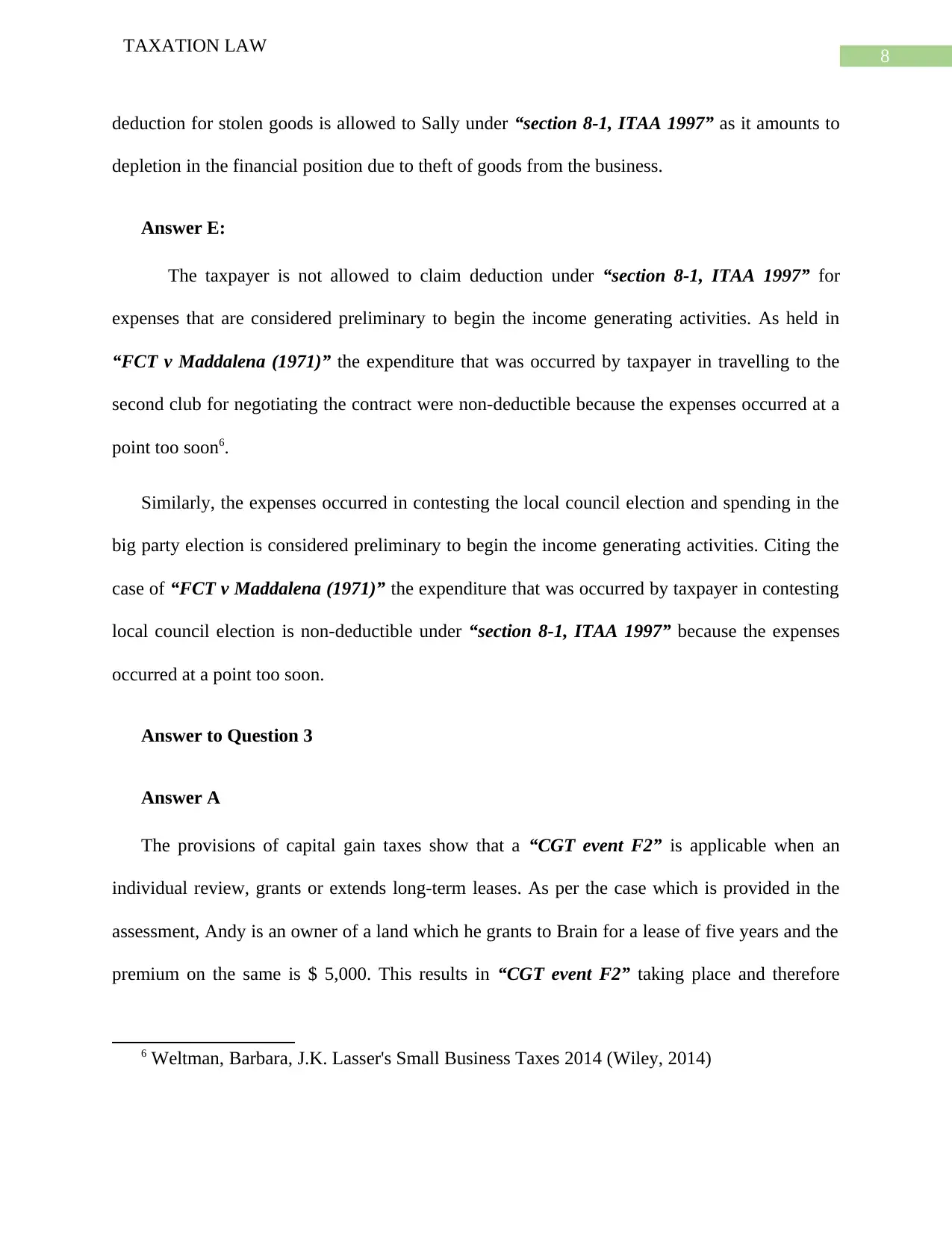
8
TAXATION LAW
deduction for stolen goods is allowed to Sally under “section 8-1, ITAA 1997” as it amounts to
depletion in the financial position due to theft of goods from the business.
Answer E:
The taxpayer is not allowed to claim deduction under “section 8-1, ITAA 1997” for
expenses that are considered preliminary to begin the income generating activities. As held in
“FCT v Maddalena (1971)” the expenditure that was occurred by taxpayer in travelling to the
second club for negotiating the contract were non-deductible because the expenses occurred at a
point too soon6.
Similarly, the expenses occurred in contesting the local council election and spending in the
big party election is considered preliminary to begin the income generating activities. Citing the
case of “FCT v Maddalena (1971)” the expenditure that was occurred by taxpayer in contesting
local council election is non-deductible under “section 8-1, ITAA 1997” because the expenses
occurred at a point too soon.
Answer to Question 3
Answer A
The provisions of capital gain taxes show that a “CGT event F2” is applicable when an
individual review, grants or extends long-term leases. As per the case which is provided in the
assessment, Andy is an owner of a land which he grants to Brain for a lease of five years and the
premium on the same is $ 5,000. This results in “CGT event F2” taking place and therefore
6 Weltman, Barbara, J.K. Lasser's Small Business Taxes 2014 (Wiley, 2014)
TAXATION LAW
deduction for stolen goods is allowed to Sally under “section 8-1, ITAA 1997” as it amounts to
depletion in the financial position due to theft of goods from the business.
Answer E:
The taxpayer is not allowed to claim deduction under “section 8-1, ITAA 1997” for
expenses that are considered preliminary to begin the income generating activities. As held in
“FCT v Maddalena (1971)” the expenditure that was occurred by taxpayer in travelling to the
second club for negotiating the contract were non-deductible because the expenses occurred at a
point too soon6.
Similarly, the expenses occurred in contesting the local council election and spending in the
big party election is considered preliminary to begin the income generating activities. Citing the
case of “FCT v Maddalena (1971)” the expenditure that was occurred by taxpayer in contesting
local council election is non-deductible under “section 8-1, ITAA 1997” because the expenses
occurred at a point too soon.
Answer to Question 3
Answer A
The provisions of capital gain taxes show that a “CGT event F2” is applicable when an
individual review, grants or extends long-term leases. As per the case which is provided in the
assessment, Andy is an owner of a land which he grants to Brain for a lease of five years and the
premium on the same is $ 5,000. This results in “CGT event F2” taking place and therefore
6 Weltman, Barbara, J.K. Lasser's Small Business Taxes 2014 (Wiley, 2014)
⊘ This is a preview!⊘
Do you want full access?
Subscribe today to unlock all pages.

Trusted by 1+ million students worldwide
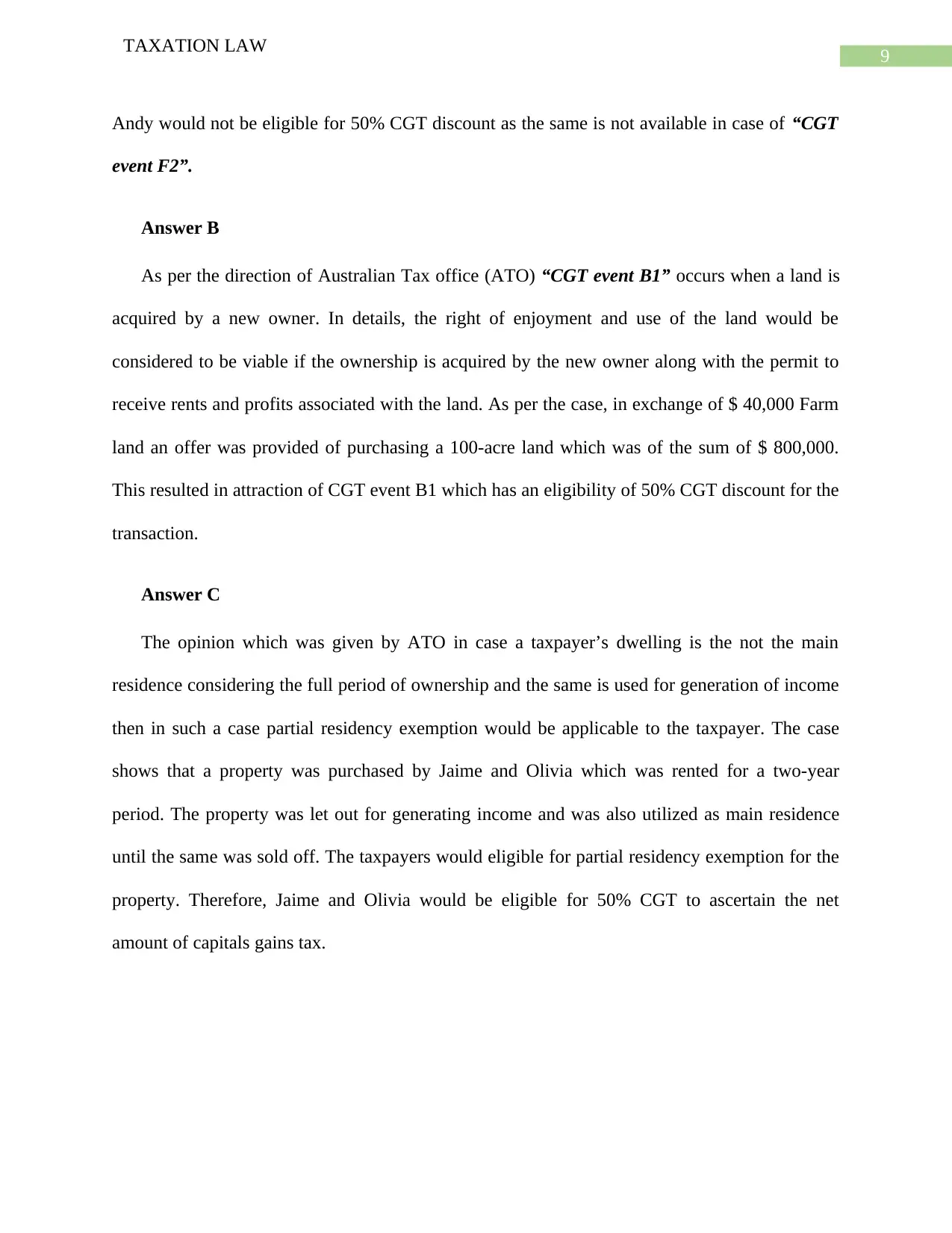
9
TAXATION LAW
Andy would not be eligible for 50% CGT discount as the same is not available in case of “CGT
event F2”.
Answer B
As per the direction of Australian Tax office (ATO) “CGT event B1” occurs when a land is
acquired by a new owner. In details, the right of enjoyment and use of the land would be
considered to be viable if the ownership is acquired by the new owner along with the permit to
receive rents and profits associated with the land. As per the case, in exchange of $ 40,000 Farm
land an offer was provided of purchasing a 100-acre land which was of the sum of $ 800,000.
This resulted in attraction of CGT event B1 which has an eligibility of 50% CGT discount for the
transaction.
Answer C
The opinion which was given by ATO in case a taxpayer’s dwelling is the not the main
residence considering the full period of ownership and the same is used for generation of income
then in such a case partial residency exemption would be applicable to the taxpayer. The case
shows that a property was purchased by Jaime and Olivia which was rented for a two-year
period. The property was let out for generating income and was also utilized as main residence
until the same was sold off. The taxpayers would eligible for partial residency exemption for the
property. Therefore, Jaime and Olivia would be eligible for 50% CGT to ascertain the net
amount of capitals gains tax.
TAXATION LAW
Andy would not be eligible for 50% CGT discount as the same is not available in case of “CGT
event F2”.
Answer B
As per the direction of Australian Tax office (ATO) “CGT event B1” occurs when a land is
acquired by a new owner. In details, the right of enjoyment and use of the land would be
considered to be viable if the ownership is acquired by the new owner along with the permit to
receive rents and profits associated with the land. As per the case, in exchange of $ 40,000 Farm
land an offer was provided of purchasing a 100-acre land which was of the sum of $ 800,000.
This resulted in attraction of CGT event B1 which has an eligibility of 50% CGT discount for the
transaction.
Answer C
The opinion which was given by ATO in case a taxpayer’s dwelling is the not the main
residence considering the full period of ownership and the same is used for generation of income
then in such a case partial residency exemption would be applicable to the taxpayer. The case
shows that a property was purchased by Jaime and Olivia which was rented for a two-year
period. The property was let out for generating income and was also utilized as main residence
until the same was sold off. The taxpayers would eligible for partial residency exemption for the
property. Therefore, Jaime and Olivia would be eligible for 50% CGT to ascertain the net
amount of capitals gains tax.
Paraphrase This Document
Need a fresh take? Get an instant paraphrase of this document with our AI Paraphraser
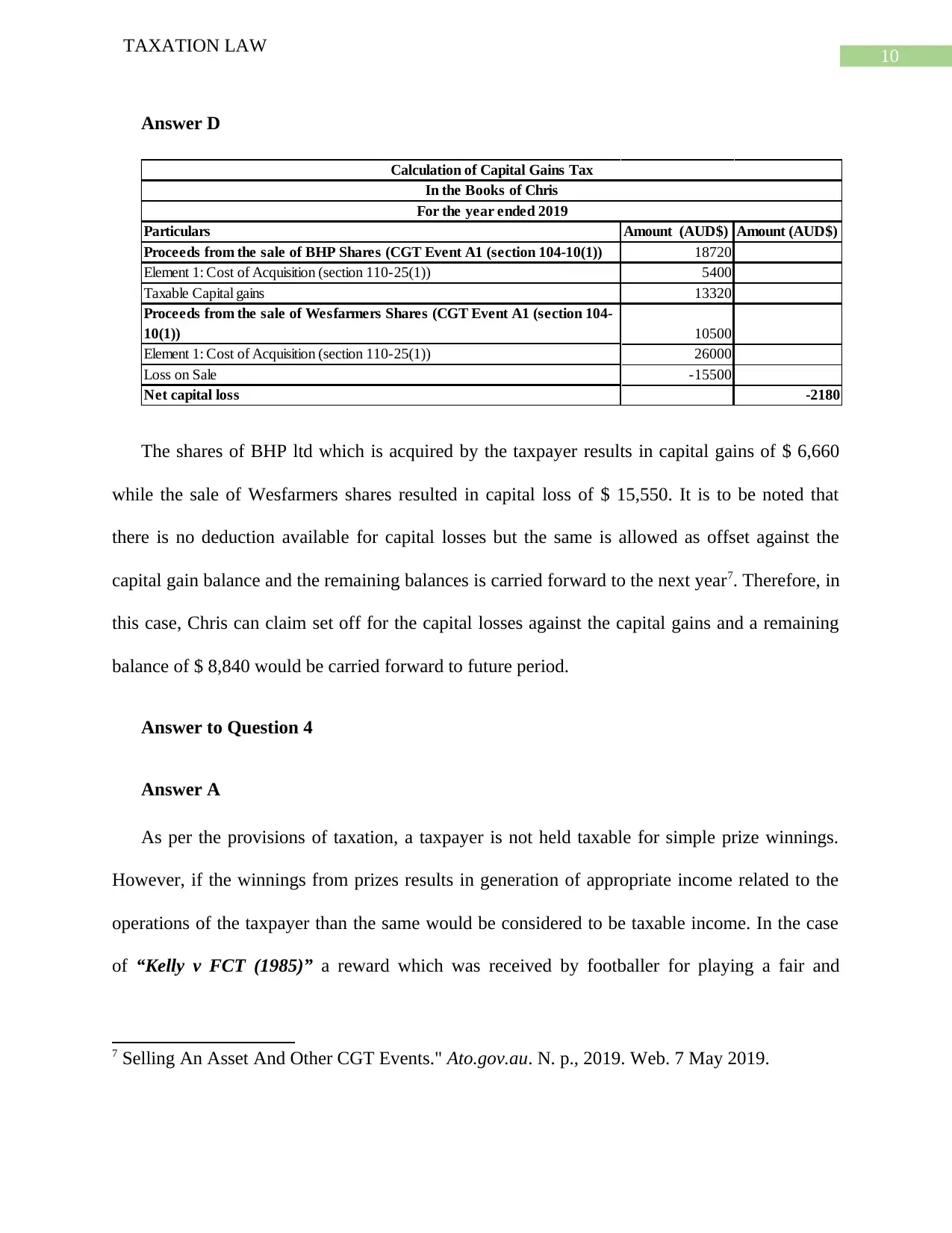
10
TAXATION LAW
Answer D
Particulars Amount (AUD$) Amount (AUD$)
Proceeds from the sale of BHP Shares (CGT Event A1 (section 104-10(1)) 18720
Element 1: Cost of Acquisition (section 110-25(1)) 5400
Taxable Capital gains 13320
Proceeds from the sale of Wesfarmers Shares (CGT Event A1 (section 104-
10(1)) 10500
Element 1: Cost of Acquisition (section 110-25(1)) 26000
Loss on Sale -15500
Net capital loss -2180
Calculation of Capital Gains Tax
In the Books of Chris
For the year ended 2019
The shares of BHP ltd which is acquired by the taxpayer results in capital gains of $ 6,660
while the sale of Wesfarmers shares resulted in capital loss of $ 15,550. It is to be noted that
there is no deduction available for capital losses but the same is allowed as offset against the
capital gain balance and the remaining balances is carried forward to the next year7. Therefore, in
this case, Chris can claim set off for the capital losses against the capital gains and a remaining
balance of $ 8,840 would be carried forward to future period.
Answer to Question 4
Answer A
As per the provisions of taxation, a taxpayer is not held taxable for simple prize winnings.
However, if the winnings from prizes results in generation of appropriate income related to the
operations of the taxpayer than the same would be considered to be taxable income. In the case
of “Kelly v FCT (1985)” a reward which was received by footballer for playing a fair and
7 Selling An Asset And Other CGT Events." Ato.gov.au. N. p., 2019. Web. 7 May 2019.
TAXATION LAW
Answer D
Particulars Amount (AUD$) Amount (AUD$)
Proceeds from the sale of BHP Shares (CGT Event A1 (section 104-10(1)) 18720
Element 1: Cost of Acquisition (section 110-25(1)) 5400
Taxable Capital gains 13320
Proceeds from the sale of Wesfarmers Shares (CGT Event A1 (section 104-
10(1)) 10500
Element 1: Cost of Acquisition (section 110-25(1)) 26000
Loss on Sale -15500
Net capital loss -2180
Calculation of Capital Gains Tax
In the Books of Chris
For the year ended 2019
The shares of BHP ltd which is acquired by the taxpayer results in capital gains of $ 6,660
while the sale of Wesfarmers shares resulted in capital loss of $ 15,550. It is to be noted that
there is no deduction available for capital losses but the same is allowed as offset against the
capital gain balance and the remaining balances is carried forward to the next year7. Therefore, in
this case, Chris can claim set off for the capital losses against the capital gains and a remaining
balance of $ 8,840 would be carried forward to future period.
Answer to Question 4
Answer A
As per the provisions of taxation, a taxpayer is not held taxable for simple prize winnings.
However, if the winnings from prizes results in generation of appropriate income related to the
operations of the taxpayer than the same would be considered to be taxable income. In the case
of “Kelly v FCT (1985)” a reward which was received by footballer for playing a fair and
7 Selling An Asset And Other CGT Events." Ato.gov.au. N. p., 2019. Web. 7 May 2019.
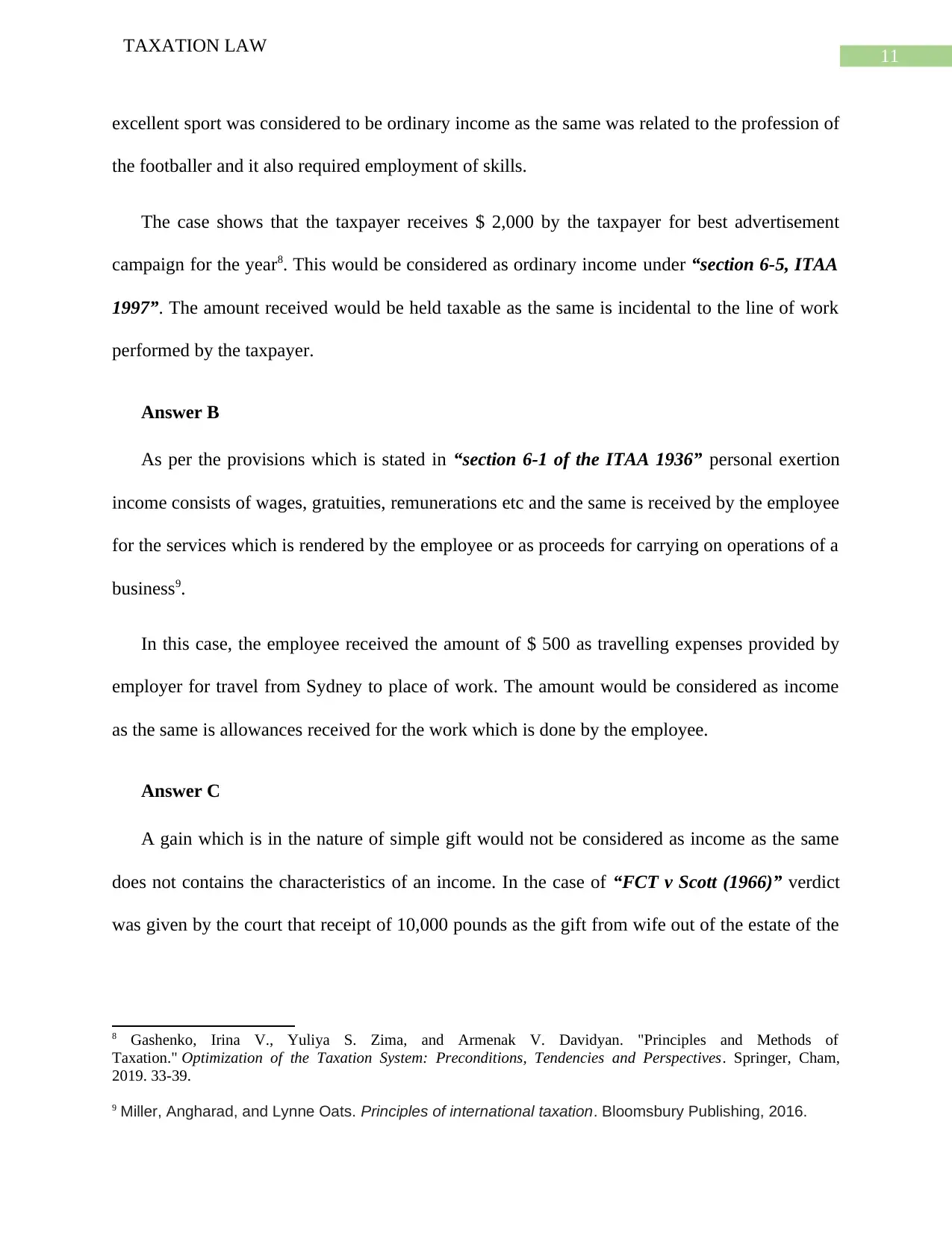
11
TAXATION LAW
excellent sport was considered to be ordinary income as the same was related to the profession of
the footballer and it also required employment of skills.
The case shows that the taxpayer receives $ 2,000 by the taxpayer for best advertisement
campaign for the year8. This would be considered as ordinary income under “section 6-5, ITAA
1997”. The amount received would be held taxable as the same is incidental to the line of work
performed by the taxpayer.
Answer B
As per the provisions which is stated in “section 6-1 of the ITAA 1936” personal exertion
income consists of wages, gratuities, remunerations etc and the same is received by the employee
for the services which is rendered by the employee or as proceeds for carrying on operations of a
business9.
In this case, the employee received the amount of $ 500 as travelling expenses provided by
employer for travel from Sydney to place of work. The amount would be considered as income
as the same is allowances received for the work which is done by the employee.
Answer C
A gain which is in the nature of simple gift would not be considered as income as the same
does not contains the characteristics of an income. In the case of “FCT v Scott (1966)” verdict
was given by the court that receipt of 10,000 pounds as the gift from wife out of the estate of the
8 Gashenko, Irina V., Yuliya S. Zima, and Armenak V. Davidyan. "Principles and Methods of
Taxation." Optimization of the Taxation System: Preconditions, Tendencies and Perspectives. Springer, Cham,
2019. 33-39.
9 Miller, Angharad, and Lynne Oats. Principles of international taxation. Bloomsbury Publishing, 2016.
TAXATION LAW
excellent sport was considered to be ordinary income as the same was related to the profession of
the footballer and it also required employment of skills.
The case shows that the taxpayer receives $ 2,000 by the taxpayer for best advertisement
campaign for the year8. This would be considered as ordinary income under “section 6-5, ITAA
1997”. The amount received would be held taxable as the same is incidental to the line of work
performed by the taxpayer.
Answer B
As per the provisions which is stated in “section 6-1 of the ITAA 1936” personal exertion
income consists of wages, gratuities, remunerations etc and the same is received by the employee
for the services which is rendered by the employee or as proceeds for carrying on operations of a
business9.
In this case, the employee received the amount of $ 500 as travelling expenses provided by
employer for travel from Sydney to place of work. The amount would be considered as income
as the same is allowances received for the work which is done by the employee.
Answer C
A gain which is in the nature of simple gift would not be considered as income as the same
does not contains the characteristics of an income. In the case of “FCT v Scott (1966)” verdict
was given by the court that receipt of 10,000 pounds as the gift from wife out of the estate of the
8 Gashenko, Irina V., Yuliya S. Zima, and Armenak V. Davidyan. "Principles and Methods of
Taxation." Optimization of the Taxation System: Preconditions, Tendencies and Perspectives. Springer, Cham,
2019. 33-39.
9 Miller, Angharad, and Lynne Oats. Principles of international taxation. Bloomsbury Publishing, 2016.
⊘ This is a preview!⊘
Do you want full access?
Subscribe today to unlock all pages.

Trusted by 1+ million students worldwide
1 out of 16
Related Documents
Your All-in-One AI-Powered Toolkit for Academic Success.
+13062052269
info@desklib.com
Available 24*7 on WhatsApp / Email
![[object Object]](/_next/static/media/star-bottom.7253800d.svg)
Unlock your academic potential
Copyright © 2020–2025 A2Z Services. All Rights Reserved. Developed and managed by ZUCOL.





